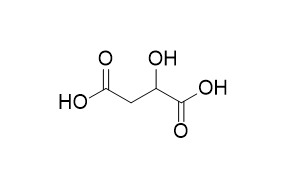DL-Malic acid
DL-malic acid supplementation improves the carcass characteristics of finishing Pelibuey lambs. DL-malic acid can inhibit the floatability of muscovite.
Inquire / Order:
manager@chemfaces.com
Technical Inquiries:
service@chemfaces.com
Tel:
+86-27-84237783
Fax:
+86-27-84254680
Address:
1 Building, No. 83, CheCheng Rd., Wuhan Economic and Technological Development Zone, Wuhan, Hubei 430056, PRC
Providing storage is as stated on the product vial and the vial is kept tightly sealed, the product can be stored for up to
24 months(2-8C).
Wherever possible, you should prepare and use solutions on the same day. However, if you need to make up stock solutions in advance, we recommend that you store the solution as aliquots in tightly sealed vials at -20C. Generally, these will be useable for up to two weeks. Before use, and prior to opening the vial we recommend that you allow your product to equilibrate to room temperature for at least 1 hour.
Need more advice on solubility, usage and handling? Please email to: service@chemfaces.com
The packaging of the product may have turned upside down during transportation, resulting in the natural compounds adhering to the neck or cap of the vial. take the vial out of its packaging and gently shake to let the compounds fall to the bottom of the vial. for liquid products, centrifuge at 200-500 RPM to gather the liquid at the bottom of the vial. try to avoid loss or contamination during handling.
Int J Mol Sci.2020, 21(8):2790.
Int J Mol Sci.2020, 21(19),7070.
Antioxidants (Basel).2022, 11(12):2496.
Sci Adv.2018, 4(10)
Chengdu University of Traditional Chinese Medicine2024, 4802935.
Food Chem X.2024, 21:101127.
Int J Mol Sci.2021, 22(19):10405.
Clin Exp Pharmacol Physiol.2020, doi: 10.1111
Pol J Microbiol.2021, 70(1):117-130.
Research on Crops.2017, 18(3):569
Related and Featured Products
Conservation and Utilization of Mineral Resources, 2018.
Inhibition Mechanism of DL-malic Acid on the Floatability of Muscovite.[Reference:
WebLink]
METHODS AND RESULTS:
The effect of DL-Malic acid on the floatability of muscovite was investigated under sodium oleate system,and the mechanism of DL-Malic acid on muscovite was researched by means of FTIR and XPS spectra etc.
CONCLUSIONS:
The results show that floatability of muscovite can be prominently inhibited by DL-Malic acid,because C_4H_5O_5~- and C_4H_4O_5~(2-) which from DL-Malic acid solution could occur competitive adsorption with oleate ions in the pulp,and C_4H_5O_5~- and C_4H_4O_5~(2-) which adsorbed on muscovite surface aroused its surface zeta potential negative direction increase,which caused the electrostatic adsorption action of oleate ions in muscovite surface was weakened. Moreover,C_4H_5O_5~- and C_4H_4O_5~(2-) contain strong hydrophilic groups,these ions of which adsorbed on muscovite surface caused its surface had hydrophilicity,therefore the floatability of muscovite was inhibited.
Journal of Animal ence(3):1048-1057.
Effect of DL-malic acid supplementation on feed intake, methane emission, and rumen fermentation in beef cattle.[Reference:
WebLink]
The objective of this study was to determine the effect of dietary concentration of DL-Malic acid (MA) on DMI, CH(4) emission, and rumen fermentation in beef cattle.
METHODS AND RESULTS:
Two Latin square experiments were conducted. In Exp. 1, six beef heifers (19 +/- 1 mo old) were assigned in a duplicated Latin square to 1 of 3 dietary concentrations of MA on a DMI basis (0%, MA-0; 3.75%, MA-3.75; or 7.5%, MA-7.5) over 3 periods. In Exp. 2, four rumen-fistulated steers (48 +/- 1 mo old) were assigned to 1 of 4 dietary concentrations of MA (0%, MA-0; 2.5%, MA-2.5; 5.0%, MA-5.0; or 7.5%, MA-7.5) on a DMI basis, over 4 periods. Both experimental diets consisted of grass silage and pelleted concentrate (containing MA). Silage was fed ad libitum once daily (a.m.), whereas concentrate was fed twice daily (a.m. and p.m.) with the aim of achieving a total DMI of 40:60 silage:concentrate. In both Exp. 1 and 2, experimental periods consisted of 28 d, incorporating a 13-d acclimatization, a 5-d measurement period, and a 10-d washout period. In Exp. 1, enteric CH(4), feed apparent digestibility, and feed intake were measured over the 5-d measurement period. In Exp. 2, rumen fluid was collected on d 16 to 18, immediately before (a.m.) feeding and 2, 4, 6, and 8 h thereafter. Rumen pH was determined and samples were taken for protozoa count, VFA, and ammonia analysis.
Enteric CH(4) emissions were estimated by using the sulfur hexafluoride tracer technique and feed apparent digestibility was estimated by using chromic oxide as an external marker for fecal output.
CONCLUSIONS:
In Exp. 1, increasing dietary MA led to a linear decrease in total DMI (P < 0.001) and total daily CH(4) emissions (P < 0.001). Compared with the control diet, the greatest concentration of MA decreased total daily CH(4) emissions by 16%, which corresponded to a 9% reduction per unit of DMI. Similarly, in Exp. 2, inclusion of MA reduced DMI in a linear (P = 0.002) and quadratic (P < 0.001) fashion. Increasing dietary MA led to a linear decrease in molar proportion of acetic (P = 0.004) and butyric acids (P < 0.001) and an increase in propionic acid (P < 0.001). Ruminal pH tended to increase (P = 0.10) with increasing dietary MA. Dietary inclusion of MA led to a linear (P = 0.01) decrease in protozoa numbers. Increasing supplementation with MA decreased CH(4) emissions, but DMI was also decreased, which could have potentially negative effects on animal performance.
JOURNAL OF INSTRUMENTAL ANALYSIS, 1999.
Determination of DL-Malic Acid by Potassium Permanganate Chemiluminescence System.[Reference:
WebLink]
METHODS AND RESULTS:
A new detection method for DL-Malic acid was established based on the chemiluminescence of potassium permanganate in sulfuric acid solution. It has a linear response range of 1.0×10-6~1.0×10-2 mol·L-1 and a detection limit of 1.0×10-9 mol·L-1 for DL-Malic acid. Parallel analysis of samples with a certain concentration showed RSD of 1.4%(n=8). Good results for determination of real samples of apple juice and drink are obtained by this method.
CONCLUSIONS:
Due to its good reproducibility, simplicity and sensitivity, this method has broad prospects of application. Mechanism of chemiluminescence and self _ catalytic attribute of this system were briefly discussed.



